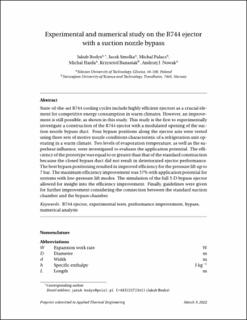| dc.contributor.author | Bodys, Jakub | |
| dc.contributor.author | Smołka, Jacek | |
| dc.contributor.author | Palacz, Michał | |
| dc.contributor.author | Haida, Michal | |
| dc.contributor.author | Banasiak, Krzysztof | |
| dc.contributor.author | Nowak, Andrzej J | |
| dc.date.accessioned | 2022-09-09T11:04:13Z | |
| dc.date.available | 2022-09-09T11:04:13Z | |
| dc.date.created | 2021-10-25T11:11:43Z | |
| dc.date.issued | 2021 | |
| dc.identifier.citation | Applied Thermal Engineering. 2021, 194 . | en_US |
| dc.identifier.issn | 1359-4311 | |
| dc.identifier.uri | https://hdl.handle.net/11250/3016860 | |
| dc.description.abstract | State-of-the-art R744 cooling cycles include highly efficient ejectors as a crucial element for competitive energy consumption in warm climates. However, an improvement is still possible, as shown in this study. This study is the first to experimentally investigate a construction of the R744 ejector with a modulated opening of the suction nozzle bypass duct. Four bypass positions along the ejector axis were tested using three sets of motive nozzle conditions characteristic of a refrigeration unit operating in a warm climate. Two levels of evaporation temperature, as well as the superheat influence, were investigated to evaluate the application potential. The efficiency of the prototype was equal to or greater than that of the standard construction because the closed bypass duct did not result in deteriorated ejector performance. The best bypass positioning resulted in improved efficiency for the pressure lift up to 7 bar. The maximum efficiency improvement was 37% with application potential for systems with low-pressure lift modes. The simulation of the full 3-D bypass ejector allowed for insight into the efficiency improvement. Finally, guidelines were given for further improvement considering the connection between the standard suction chamber and the bypass chamber. | en_US |
| dc.language.iso | eng | en_US |
| dc.publisher | Elsevier | en_US |
| dc.rights | Attribution-NonCommercial-NoDerivatives 4.0 Internasjonal | * |
| dc.rights.uri | http://creativecommons.org/licenses/by-nc-nd/4.0/deed.no | * |
| dc.title | Experimental and numerical study on the R744 ejector with a suction nozzle bypass | en_US |
| dc.type | Peer reviewed | en_US |
| dc.type | Journal article | en_US |
| dc.description.version | acceptedVersion | en_US |
| dc.rights.holder | This is the authors' accepted manuscript to an article published by Elsevier. Locked until 20.5.2023 due to copyright restrictions. | en_US |
| dc.source.pagenumber | 13 | en_US |
| dc.source.volume | 194 | en_US |
| dc.source.journal | Applied Thermal Engineering | en_US |
| dc.identifier.doi | 10.1016/j.applthermaleng.2021.117015 | |
| dc.identifier.cristin | 1948177 | |
| cristin.ispublished | true | |
| cristin.fulltext | postprint | |
| cristin.qualitycode | 1 | |

